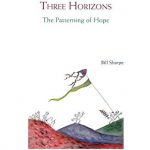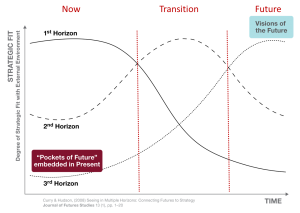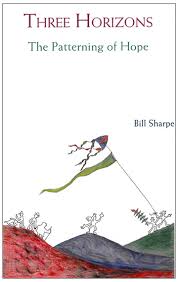 Just finished Bill Sharpe’s Three Horizons: The Patterning of Hope, 2013. I often refer to a slide below as my “desert island” slide. That is, if I had one slide to explain the future, this would be it. It comes from Andrew Curry and Tony Hodgson, who wrote”Seeing in Multiple Horizons,” an article for the Journal of Futures Studies that I nominated for an APF MSFW award (which it won).
Just finished Bill Sharpe’s Three Horizons: The Patterning of Hope, 2013. I often refer to a slide below as my “desert island” slide. That is, if I had one slide to explain the future, this would be it. It comes from Andrew Curry and Tony Hodgson, who wrote”Seeing in Multiple Horizons,” an article for the Journal of Futures Studies that I nominated for an APF MSFW award (which it won).
We have also incorporated three horizons language into our “domain description” template in the “Framing” step of Framework Foresight, in  which we set the timeframe of our domain (the topic we are exploring). We also use the Three Horizons model to situate our scanning, as we label scanning hits according to which time horizon they indicate.
which we set the timeframe of our domain (the topic we are exploring). We also use the Three Horizons model to situate our scanning, as we label scanning hits according to which time horizon they indicate.
My initial introduction to the concept was to the McKinsey version in the Alchemy of Growth. When I took the job as Ideation Leader in New Business Development at Dow Chemical, I was handed that book and told to read it. One of my rules of thumb, “when in Rome….” so I adopted the Three Horizons language and model. It actually appeared in my 2003 article “Organizational Futurist Audit” as “Know Your Time Horizon.”
At this point you may be thinking, he likes this Three Horizons! Indeed!
So, that takes me to Bill Sharpe’s book. The background was useful, I hope, to illustrate how it has changed my thinking on the three horizons. My experience with the Mckinsey version led me to think of H2 as space of line extensions. H1 as the current product line, H2 as extension, and H3 as really new stuff. I don’t believe it is totally at odds with the Sharpe (and Curry and Hodgson) conception, but it is different. What the book brought home for me (and maybe I should have seen this earlier) is that the key transition is not from H1 to H2, but rather from H1 to H3, with H2 as a zone of transition. We move from H1 to H3, and H2 is “where tensions and transitions are played out between the continuous improvement of H1 and the transformative possibilities of H3.”
It can help us with clients to reframe H2 innovations as going somewhere else, so to speak. A neat concept in the book notes that some innovations are “absorbed” by the existing H2 system – what he calls H1 capture — while others take us forward to the third horizon — the h2+ innovations.
I found that distinction made the book worthwhile. It’s a short book, and as the title implies, there is a fair bit of it on the “hope” aspect. As a methods geek, I didn’t find that as helpful. And there are some case studies that some may find useful as well. I’m very happy to have read it and it’s making me think about how it fits with our interpretation of the archetype methods. Hmmmm. Andy Hines

Leave a Reply